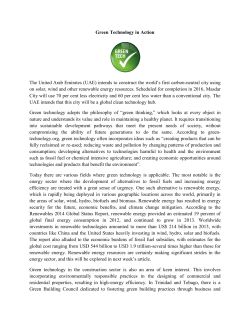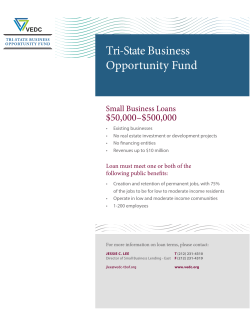
International Ground Source Heat Pump Association
Geothermal Heat Pump systems – Renewable energy under your feet -Roshan Revankar International Ground Source Heat Pump Association, USA GSHP System Cooling Concept Temperature of the earth is relatively constant. When cooling is needed in our buildings the relatively cool ground easily absorbs heat removed from our buildings. Heat Sink GSHP System Heating Concept Warm Source Types of Ground Source Heat Pumps How is it renewable? Coefficient of Performance (COP)= 10/2.7=3.7 6 kWh T Natural Gas Combined-Cycle Power Plant Generation and Natural Gas Transmission Losses 35-55 % 6 kWh efficiency thermal 6 x .55 = 3.3 kWh E 2.7 kWh E Ground Source Heat Pump 7.3kWht Free Energy From Ground 10 kWh T For Heating Cooling and Hot water US Market - 29 % of global GSHP installations - $15.7 billion in 2013 including design, equipment and installation 18 Buildings 1,360,000 sq ft 2,611 kW savings International: Geothermal Heat Pump Systems • Sweden 9 million people 45,000 GHP year • S. Korea 123 story LWT 50,000 people downtown • China Bird's Nest Stadium and other Olympic venues for the 2008 Olympics • GSHP in England, Belgium, France, Sweden, Germany, Ireland, Romania, Switzerland Lotte World Tower Seoul S. Korea Financial Incentives • Federal level : 30% tax credit for residential and 10% for commercial buildings. • State Incentives: New Mexico Massachusetts 30% Personal Tax credit State Rebate Program $1,500 - $12,500 (size,type,eff.) Max- $9,000 Funding- Renewable Energy Funding- State funds Trust Fund Pennsylvania Industry Recruitment/Support Oklahoma Manufacturer loans: $40,000 Green home Loan Program per job created within 3 years Max- $15,000 Manufacturer grants: $5,000 3% interest rate for 48 months per job created within 3 years Funding- American Recovery Loans for geothermal and Reinvestment Act 2009 systems: $3 per square foot of space served up to $5 millionFunding- Alternative Energy Investment Fund (state issued bonds) Utility loans and rebates Illinois Utility Rebate Program City Water Light and Power $500 per ton Colorado Utility Rebate Program Black Hills Energy $1,200 (14.1 EER and above) Oklahoma Utility Loan Program Oklahoma Municipal Power Authority Unsecured Loan: $5,000 $35,000 @1% (3 yrs) Home Equity Loan: $1,000 $100,000 @0.025% (15 yrs) Georgia Utility Loan Program Tennessee valley authority Single Unit: up to $10,000 Multiple and Advanced Units: up to $12,500 @ 6-8% (up to 10 years) What did China do? Areas to consider for India GSHP specific policies and incentives Equipment Market development GSHP Applications Standards and Certifications Thank you! Rules, Regulations and Policies • Renewable Energy Portfolio Standard: require utilities to use or procure renewable energy or renewable energy credits (RECs) to account for a certain percentage of their retail electricity sales -- or a certain amount of generating capacity -- according to a specified schedule. • • Energy efficiency resource standards (EERS) are state policies that require utilities to meet specific targets for energy savings according to a set schedule. EERS policies establish separate reduction targets for electricity sales, peak electric demand and/or natural gas consumption. • • Eg. 20 % by 2020 in Maryland 30% reduction in annual growth in demand 2013 and beyond in Texas Energy standards for Public Buildings Many states and local governments, as well as the federal government, have chosen to lead by example by requiring new government buildings to meet strict energy standards. Policies designed to encourage the use of on-site renewables generally establish conditional requirements tied to life-cycle cost analysis. • Achieve an 80% reduction from baseline year 2001-02 greenhouse gas emissions by 2050 in North Carolina
© Copyright 2025















